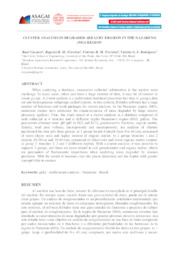Cluster analysis in degraded areas by erosion in the Nazareno (MG) region.
Cluster analysis in degraded areas by erosion in the Nazareno (MG) region.
Author(s): CASSARO, R.; FERREIRA, R. R. M.; FERREIRA, V. R. M.; RODRIGUES, V. G. S.
Summary: Abstract: When analyzing a database, summarize collected information is the analyst main challenge. In many cases, when you have a large number of data, it may be of interest to create groups. A cluster analysis is a multivariate statistical procedure that tries to group a data set into homogeneous subgroups, called clusters. In this context, RStudio software has a large number of functions and work packages for cluster analysis. In the Nazareno region (MG), numerous studies have addressed the characterization of areas degraded by large erosive processes (gullies). Thus, this study aimed at a cluster analysis in a database composed of soils collected in 4 trenches and at different depths Nazareno?s region (MG) gullies. The parameters obtained were: pH (pH in H2O and KCl), granulometric fractions, organic matter, density, total pore volume, microporosity and macroporosity. An analysis of clusters partitioned the data into three groups: a) 1 group: trench 4 (depth from 0 to 40 cm), composed of more clayey soils and higher content of organic matter; b) 2 group: trenches 1 and 2 (depths 20-30 cm and 30-40 cm), composed of siltier soils and lower organic matter content; c) group 3: trenches 1, 2 and 3 (different depths). With a cluster analysis, it was possible to separate 3 groups, and these are more related to soil granulometry and organic matter, which are parameters of fundamental importance when analyzing areas degraded by erosion processes. With the results it becomes clear the places (trenches) and the depths with greater susceptibility to erosion.
Publication year: 2021
Types of publication: Paper in annals and proceedings
Unit: Embrapa Territorial
Keywords: Gully, Multivariate analysis
Observation
Some of Embrapa's publications are published as ePub files. To read them, use or download one of the following free software options to your computer or mobile device. Android: Google Play Books; IOS: iBooks; Windows and Linux: Calibre.
Access other publications
Access the Agricultural Research Database (BDPA) to consult Embrapa's full library collection and records.
Visit Embrapa Bookstore to purchase books and other publications sold by Embrapa.

